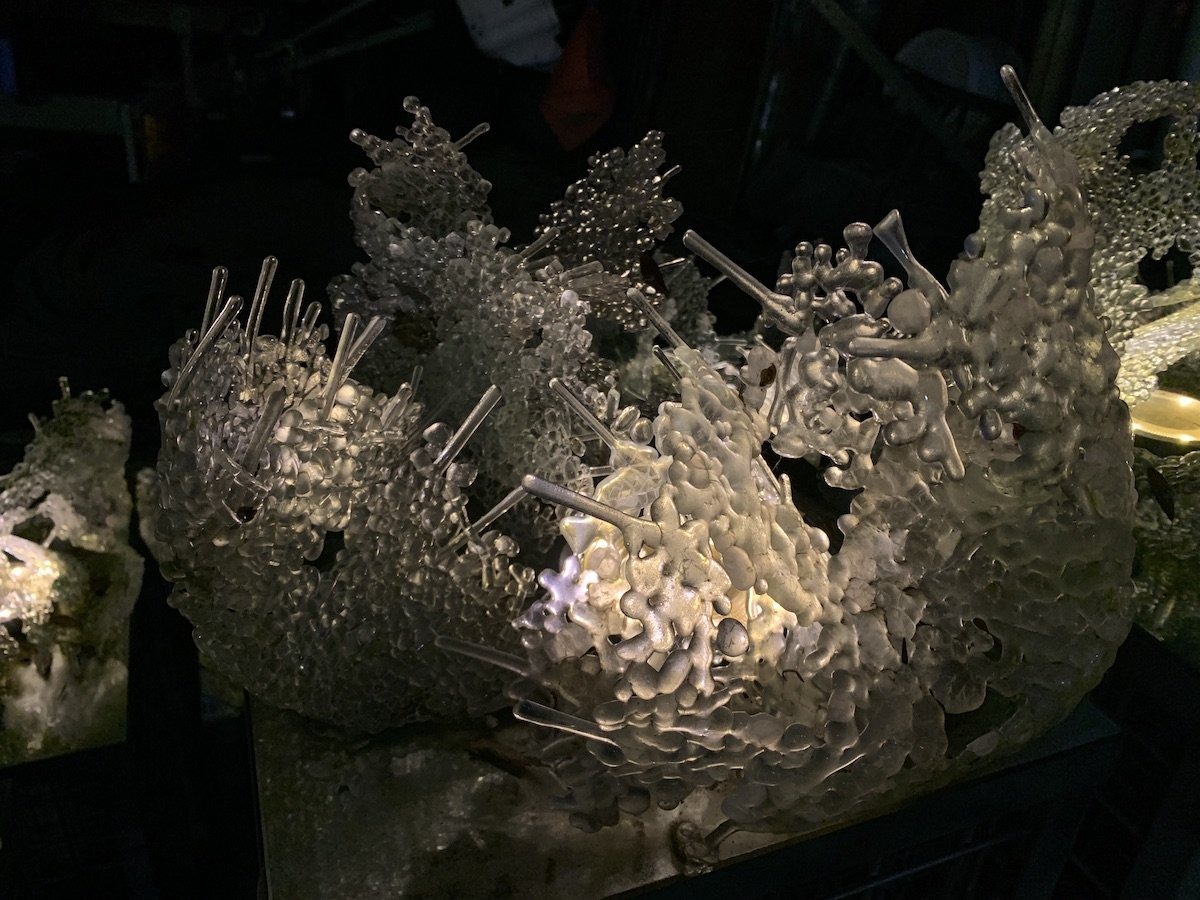Al Munro // Meet the Artist (Zig Zag Q&A Series)
July 2023
Our ongoing exhibition at The Mixing Room Gallery—Zig Zag—is open until August 12, featuring a collection of abstract painting by artists Al Munro, Hannah Beasley, Ham Darroch and Kate Vassallo.
In conjunction with the exhibition, we’ve sat down with the exhibiting artists to discuss their artworks, philosophy of beauty, and perspectives on Canberra as a place for creative practice.
For our third conversation in the Zig Zag Q&A Series, we’re chatting with Canberra-based artist Al Munro, whose interests span painting, print and drawing-based practices.
You can also check out the conversation with Hannah Beasley, and the conversation with Kate Vassallo.
In Zig Zag, Al’s works engage with the idea of subverting beauty and juxtaposing regularity and irregularity. Her handcrafted ‘pleated’ surfaces provide a distinctly sculptural base for her riotously colourful, patterned works which continue Al’s investigation of the interaction of colour, pattern and space in painting.
Drawing on her printmaking experience and keen appreciation for the dynamic nature of textiles, which constantly shift and disrupt one’s gaze, Al is exploring the intersection between mathematics, science and systems-thinking to help codify our understanding of the world.
We hope you enjoy this Q&A series!
We hope you enjoy this Q&A series and hope to see you at the Zig Zag the exhibition before it finishes on 12 August. Al is exhibiting ten works in Zig Zag (Fold 1-10) which are all available to purchase.
In recent works, you have used a folded or corrugated surface which you have likened to textile pleats. What do you enjoy about working on a three-dimensional surface?
My PhD was actually in textiles and I am interested in how textile materials move and shift. The ‘shift’ is interesting to me because of the flexibility of the textile as a substrate. When you make something with textiles, it’s not static.
With these works, I started working by folding paper mimicking textile pleats. I further developed these folded surfaces, by applying patterns and seeing what the folds do to distort or change the patterns. Sometimes I make them so that they’re even, and each corrugation is equidistant, and sometimes I make them more random.
At the moment I am working with irregular intervals and uneven grids. I am interested in the juxtaposition between regularity and irregularity. In the process of making them I have a certain amount of control because I make the structure but don’t really plan the structure, if that makes sense. I have a system for the pattern which I apply across the structure. I never know how it’s going to come together until I put paint in those last squares. There’s an interesting relationship to concrete art, that is, making art to a set of instructions. I spend quite a lot of time exploring how a regular system of variables can create quite different results.
How do you make these structures, or bases, for your paintings?
After I've finished working out ideas using folded and painted paper, I cut and glue cardboard to make the structures. It’s an archival box board; 6mm, so it’s a very sturdy cardboard used for bookbinding and box making. It’s glued together with rice paper on the ridges to firm it up. I usually make up a batch of the baseboards, then I cut a whole lot of strips and make them fit as the corrugations. That kind of determines the shape but it’s random; two strips get fitted and glued, then I make the other strips fit. There is a bit of randomness and chance to it.
“A lot of my colour choices and combinations come from colours I’ve observed in everyday settings in Thailand. There is a completely different sense of colour in Thailand - it’s not the Western sense of colour. Those kinds of colours and combinations of colours are what I come back to.”
The colours you use are very vibrant. How do you pick them?
Although I work with tonal variations to play with the optical illusions in relation to real and illusory space, I can honestly say I put together colours based on what makes me feel vaguely uncomfortable. Like an off-pink or off-mauve, or some kind of off-yellow. They have gradations of the same colour, but I’ll always include one in there that’s not graduated tonally, but goes pink, green, red, blue, so it’s random. But they still work. They would still work tonally if I took a photo and applied a monotone-filter. It’s important for me to be working from a place of discomfort; like the contrast between a yucky mustard against a cornflower blue. That’s an uncomfortable pairing and I find that subversion really interesting.
It’s probably a personal aesthetic preference because I am drawn to colours that aren’t super conventional. For example, a lot of my colour choices and combinations come from colours I’ve observed in everyday settings in Thailand.
There is a completely different sense of colour in Thailand - it’s not the Western sense of colour. Those kinds of colours and combinations of colours are what I come back to. I love the colours of the plastic shops with the vibrant shades of woven buckets or baskets for sale, and the way the shop fronts are painted in these really lurid, high-contrast hues. Like a lime green with a funny dull pink and murky mauve. I find it really easy to make things look nice and create something beautiful; but then they look too nice, and then they are too settled. With colour, I definitely need to start from a place where I am solving a problem or asking a question.
What do you mean by it being easy to make things look nice?
If I work with colours that are too analogous or harmonious, it’s too comfortable and it’s not telling me anything new. I am more interested in making work where I am resolving a question or learning something new. Ugly colours present a colour problem that needs to be resolved. It’s too easy to make pretty work. It’s more interesting to explore something where you’re learning something; to try and do something with ugly or uncomfortable colours.
How have your different stages of academic education influenced your creative practice?
Having those intense periods of study and focus and very reflective making has really structured my career and allowed me to solidify what it is I’m interested in. Also residencies along the way have been critical, just by way of having focused times of making where you don’t have to juggle this with a job - that is a really important thing. The study is good because it’s really rigorous.
There are ideas that have always been there for me - my interest in patterns, codes, algorithms, systems and signs. Systems that allow us to understand the world - pattern recognition, mathematical systems. I am interested in how mathematics and science associated fields look for the building blocks on which the world is structured. For example, how the combination of a closed set of elements can create an infinite number of possibilities.
This has run through my work from the very beginning of my education. I started training originally as a printmaker, and that’s probably where my love of pattern and repetition started. I wasn’t that interested in making an edition of prints for the sake of it. It was always for an installation where the multiplies made it work - I’ve always been interested in how patterns help us understand the world. Pattern recognition absolutely helps us make sense of the world and we are hardwired to look for meaning in these.
Lots of my work has been looking at how patterns help us understand the world – and what happens when we distort those patterns. A pattern might be applied on a grid - but what happens when you disturb the underlying grid. To this end, you might view my paintings as though you were looking at a grid of woven textiles. I’m so driven to understand what happens when you disrupt the grid.
“Lots of my work has been looking at how patterns help us understand the world – and what happens when we distort those patterns.”
How do you disrupt the grid?
I redraw patterns of grids over one another. Sometimes I do play around with ideas and will take apart a painting. For example, I bought some textiles from a market in Chiang Mai, stacks of ordinary everyday textiles, then I cut them up and re-wove them - by cutting the woven grid into strips and then a new grid from it. This led to a series of paintings where I took a pattern, sliced it and shifted it, so it’s distorted. I like slightly disrupting the woven grid. I used the logic of the warp and weft in weaving - but I painted.
I draw up my paintings before I paint them - I use a ruler. But I paint freehand and I don’t use tape. I have a structured starting point, but then paint freehand, which offers some contrast. Like my paintings of gingham - I did some rough fabric weavings first, then went with that. It just creates a system to work within - I’m not copying it. It just creates the logic, or set of instructions, for the work. Many of the paintings in Zig Zag are based on colour combinations that make me slightly uncomfortable, like red and pink.
The colour logic of weaving is interesting to me also. You can achieve a different combination of colours depending on weft over warp or warp over weft. You get some very interesting combinations which are based on rules but also have a chance elements to them. It’s the colour logic of weaving which I have used to determine the painting. I choose the base colours and then the logic of the painting determines the final colour.
I haven’t done much loom-based weaving - but I became interested in woven colours from working and teaching in the textiles workshop in the art school. I taught screen-printing. But I watched the other practices and was thinking about how they affect colour, and the specifics of those media - I found this very interesting. It’s a system - weaving is a grid. It informs and sets up a visual logic, and a decision making system. And you know how much I am interested in systems!
How would you describe your creative process?
I had my son quite young so he’s been around for as long as my art process has been around. My art practice had to fit around my family and work commitments. For years my work would be entirely comprised of small components - like collages or embroidery which I could do in small periods of time. Or when my son was playing sports, I could do some making while waiting for him in the car.
It’s really only in the past ten years that I’ve had my own time back; since my son moved out. But I’ve always had to work in a job. I’ve never had the luxury of focusing on my practice full-time. But I spend some time most days making - each night I am making, I never watch TV. I have an offsite studio at M16, and a studio at home, and I work between both.
On the weekend I work at M16. I typically work on bigger things in the studio; this allows me to have some storage and work on a larger scale. The thing that contains my time is having a full-time job because I need to pay my mortgage. I can’t not make art. So I work in a paid job during the day and in the studio at night.
Do you think beauty is objective and absolute, namely that all humans are hardwired to recognise beauty, and that there is nothing subjective about it?
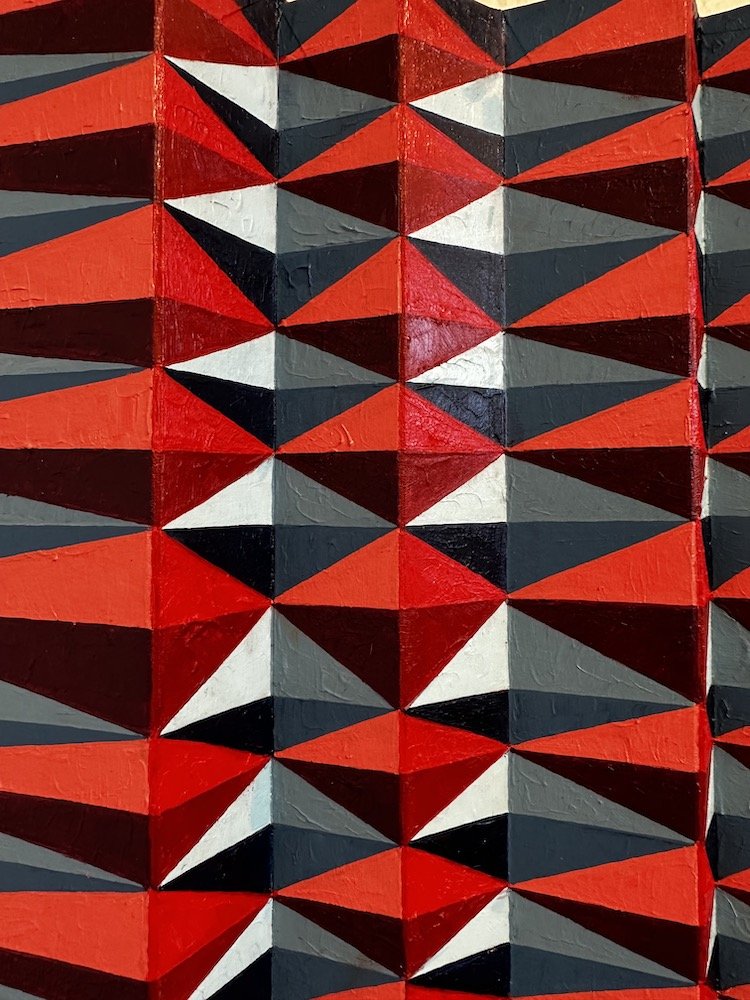
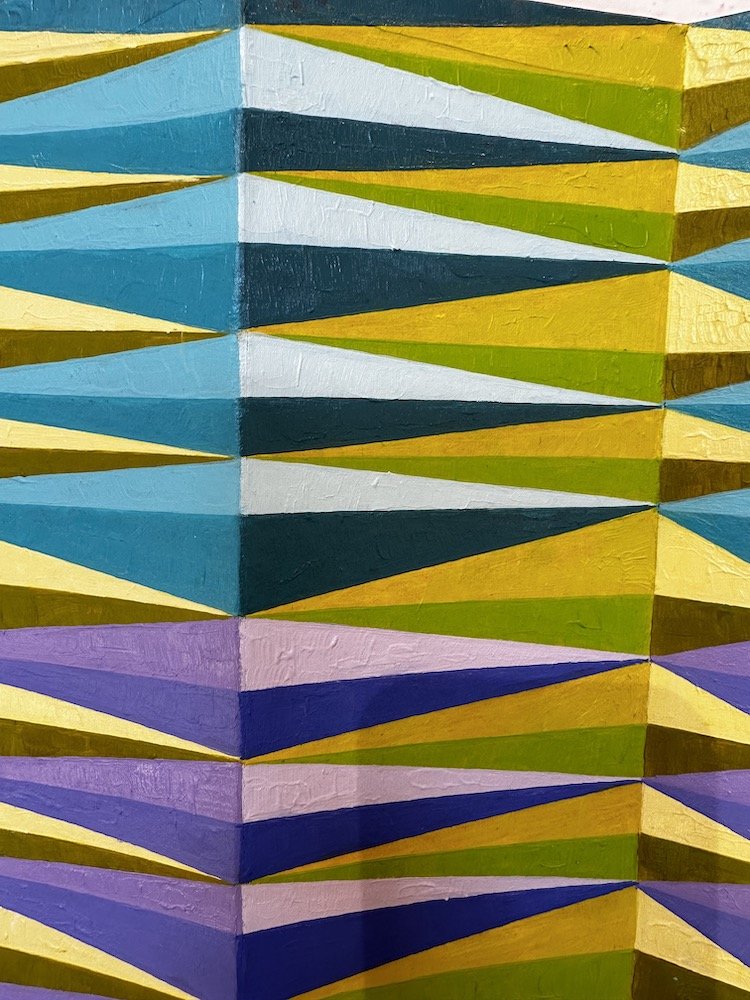
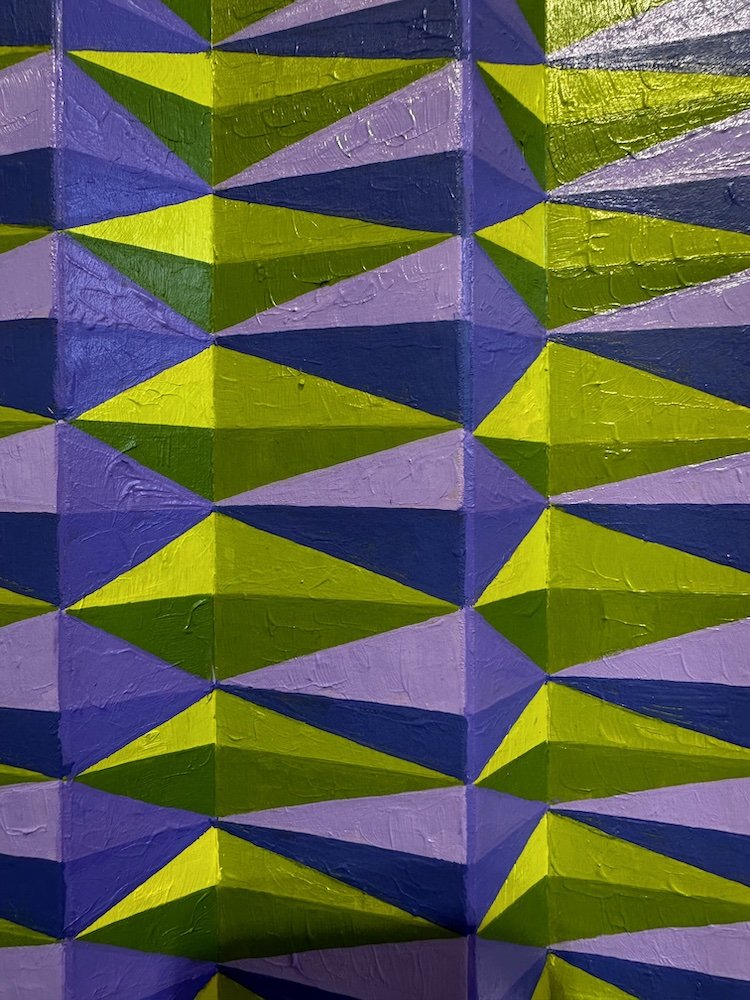
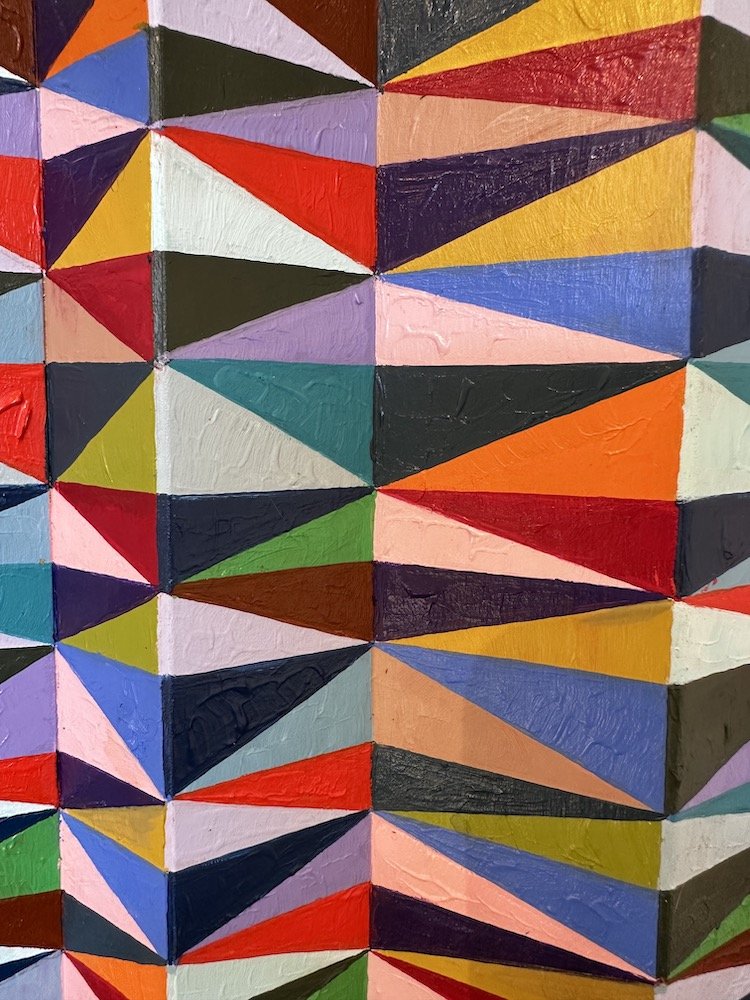
I think we’re hardwired to recognise patterns but not beauty. That’s very much dictated by social norms. What some people are attracted to is simply because they recognise a pattern that makes them feel safe. Most people don’t want to hang something challenging on their walls; people want to hang something safe, something that they know about and are already familiar with.
People aren’t that interested in things they don’t understand, or challenging art. Or they’d just rather go to IKEA; people just like things they know. Canberra is a very conservative population; aesthetically conservative.
For example, we need stronger heritage laws to stop older houses getting knocked down. A lot of older things get knocked down when they are no longer fashionable; people don’t appreciate heritage. We need to get better with our building regulations. Everyone is using cheap materials. I don’t mind concrete - I don’t mind a bit of Brutalist architecture - but we need to celebrate historical styles and not just knock them all down to put up what is fashionable now.
What have you observed about living a creative life in Canberra?
It’s odd and by choice I wouldn’t live here. I’m not a big Canberra fan. It’s kind of comfy - there are some really good artists here who are totally overlooked because they’re not part of a bigger city scene. We don’t have the depth of sector here - there’s not a very rich or interesting commercial gallery sector. That said, I am excited by Adam Bell’s new venture - the Civic Bureau - which will be showing more adventurous, contemporary work in a commercial context.
In terms of the Canberra market - the art audience - you have a clear group of people, who are normally artists, or art-friendly people. We don’t have much benefaction or support. I’d say Canberra is pretty light on by way of private philanthropic support. Other artists are buying art - not the general public. We don’t get kudos for being regional either - so we’re a bit stuck, not knowing what we are, or what market we are catering to.
What do you love about living in Canberra’s Inner North?
I love the trees and gardens. I currently live in Watson which is on the edge of the inner north. Watson is OK because it’s the gateway to Sydney, though it is a long way out from the city as far as inner North suburbs go. I’ve always been a northside person. The inner-city area is the best though. Having lived in Braddon, where I could walk to work, to the gym, to the art store, restaurants and cafes - proximity is everything. It doesn’t matter where you live, but if you live close to everything you need, that’s when you’ll probably feel the happiest.
If you have the opportunity to go out for dinner in Canberra, what are some of your favourite restaurants?
My sentimental favourite is Water’s Edge because that’s where I had my wedding reception, so we go there for birthdays and anniversaries. I also really like going to the Knox in Watson - to meet a friend for a coffee. That’s got a good community vibe, as has Gang Gang in Downer. The grassy areas in Watson and Downer are beautiful - people sit outside and have picnics etc. It’s a lovely amenity.
Which local artists are you currently most excited about?
Kate Vassallo and Hannah Beasley - I love their work - I think they’re great. They are really smart artists; their approach to that kind of rules-based art is really interesting. I think it’s just a kind of shared interest - their work is different to mine, but we have shared concerns. I guess that’s why I am finding their work interesting - exploring similar ideas. That’s really affirming, to know you’re not the only one working through certain preoccupations.
What role does art play in your home environment? Do you decorate and live with it? If so, how?
It’s huge. I am married to an anthropologist whose specialisation is Aboriginal art and whose father is an abstract expressionist painter. Between the two of us, we have an enormous collection of art. We literally have so much art! Art plays a big part in our lives; we talk about our work. It’s business as usual - it’s family life, it’s part of the fabric of family.
We have completely surrounded ourselves with art - when you walk into the house, the front formal living room, that’s my studio. So the second you walk into our house, you see the studio. It’s fundamental to our life. We love the same things. We’re just back from Spain where we loved looking at all the Moorish patterns and architecture.
Words by Ebony Levy.



